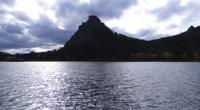Вы здесь
Burabay is pearl of Kazakhstan.

Nature tours Burabay.
"A wild onion adorns the clearings
Saturating the meadows with a tart smell
Light, cute onion heads
scattered like white pearls.”
Svetlana Lebedeva. Town of Taraz.
Trip to Burabay.
“I happened to see many of the most beautiful places in Russia in Western Europe, but I have never seen such a beautiful place in a place convenient for the capital. These natural fortresses, Ablai used well for protection from enemies.
Then the enemy usually attacked only in the summer, and all the summer months the Khan's Horde was in the forest in a clearing near the Ok-Zhetpes rock - the Arrow would not fly. At the top of the peak, an observer was on duty day and night so that the attack would not take the headquarters by surprise.
The Kazakhs called the glade the glade of Ablai. But not only in summer; in all seasons, Ablai found comfortable and reliable camps in these mountains. In the spring, he lived on the western shore of the Big Chebachy Lake, which washed the slopes of Kokshe and Chebak from the east.
The western shore jutted into the lake as a peninsula about four versts long and one and a half versts across. For a long time, waves rolled sand, silt, stones on the shore, and they were overgrown with birch, aspen, willow, willows, and thorns.
he peninsula, called by the Kazakhs Kokkaska - White with a mark, could only be reached by boat, because the depth of the lake exceeds five hundred arshins. In autumn, Khan Ablai occupies another peninsula under his command - Kotyr, at the foot of Mount Toraigyr.
This peninsula is about the same as Kokkaska. Only coastal forests are much denser here - they protect not only from raids, but also from autumn winds. In addition, by autumn, the lake becomes somewhat shallower, and islands protrude on its surface.
Ablai located his winter quarters on the leeward side of Lake Bolshoye Chebache in the Red Forest, Kyzyl-Agach. I myself spent the night in the frosty winter time in a yurt, set next to the khan's. And what is surprising is that when the yurt is well heated, it is as warm in it as in a stone or wooden house.
I will remember those winter nights in the yurt for the rest of my life. For the first time we saw the contours of Kokshe from a high cliff near the steppe lake Azat. I exclaimed then: what a miracle! I never ceased to be amazed at the blueness of the mountain, rivaling the clarity of its color with that of the summer sky.
Only the colors were a little thicker. A mirage floated closer to us. It seemed to me that the waves of the sea had lifted the mountains, and the mountain was slightly wavering on the waves, like a ship. I have seen mountains in other places, in other countries before.
From a distance, they appear blue everywhere. But such blueness as here, I have not seen before. Fascinated by such a marvelous picture, we strove to reach the Torah faster. But no matter how much we tortured the horses, the mountain did not approach us.
Only in the evening, in the rays of the setting sun, did it flash with all the colors of the rainbow and for several minutes looked motley, like a peacock's tail. And she was still far away from us. We realized that we could get to it only the next day, and spent the night in the steppe ... "
Between Okzhetpes and Kokshe, three rocky peaks rise one to one - Ushkyz, Three Girls. There is a legend that Ok-Zhetpes was once a batyr who defended his three sisters. Enemies surrounded them, approached closely. It seemed that death was inevitable. But then the batyr and his sisters turned to stone so as not to be captured.
Authority:
Archive of the town of Omsk. Diary of an unknown officer "Khanate of Ablai" with a topographic map. The book "Flashed Meteor", Sabit Mukanov.
Photos by
Alexander Petrov.







